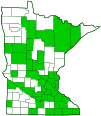common green bottle fly
(Lucilia sericata)
Conservation • Description • Habitat • Ecology • Distribution • Taxonomy
|
|
||||||||||||||
Description |
Common green bottle fly is a medium-sized blowfly. It occurs throughout the world on every continent except Greenland and Antarctica. It is common in Minnesota. It is found in a wide variety of habitats but prefers warm, moist places. It is common around farms, slaughterhouses, and garbage cans. This is often one of the first insects to visit a corpse, sometimes within minutes of death. Forensic scientists use the development of the larva of this species to determine the age of a corpse. Larvae are used on humans to painlessly remove dead or decaying tissue from wounds while leaving healthy tissue untouched and secreting a chemical that promotes tissue regeneration. Adults are ⅜″ to ½″ long, slightly larger than a house fly. The thorax is metallic bluish-green, gold, or both. It is covered with numerous short, black, bristle-like hairs (setae), and several parallel rows of long black bristles. Three grooves across the thorax delineate the three thoracic sections. On the middle section (scutum), the two rows of bristles closest to the middle each have 3 bristles. The abdomen is similar in color to the thorax. The face is silvery. The eyes are red. The antennae are black. The mouthparts are yellowish. The legs are black. The wings are clear and have light brown veins. |
Size |
Total length: ⅜″ to ½″ |
Similar Species |
Habitat |
Warm moist climates; common around farms, slaughterhouses, and garbage cans. |
Ecology |
Season |
Three or four generations per year. Early spring to late fall. |
Behavior |
|
Life Cycle |
The female deposits a mass of up to 180 white or pale yellow eggs in carrion, dung, or garbage. Over the space of 3 weeks the female will lay a total of 2,000 to 3,000 eggs in 9 or 10 batches. The number and size of batches depends on the temperature. When the eggs hatch the maggots begin feeding on the material to which they are attached. They reach full size in 4 to 9 days, enter a pre-pupal stage, then burrow into the soil. In 7 to 115 days, depending on soil temperature, the adults emerge. Over the next 48 hours the body hardens and the wings become functional. Mating begins 3 to 8 days after emergence. Adults can travel many miles searching for carrion or another suitable breeding location. In Minnesota there are 3 or 4 generations per year. The last generation overwinters in the soil as larva. |
Larva Food |
Partially decomposed animal tissue in dead fish and other animals, dung, and garbage containing animal matter. Live sheep. |
Adult Food |
Males usually feed on flower nectar; females also feed on animal tissue |
Distribution |
||
|
Sources |
|
| 9/1/2024 | ||
Occurrence |
||
Common and widespread |
||
Taxonomy |
|
Order |
|
Suborder |
Brachycera |
Infraorder |
Cyclorrhapha |
Zoosection |
Schizophora |
Zoosubsection |
|
Superfamily |
Oestroidea (Bot Flies, Blow Flies, and Allies) |
Family |
Calliphoridae (blow flies) |
Subfamily |
Luciliinae |
Tribe |
Luciliini |
Genus |
Lucilia (greenbottle flies) |
This species was formerly classified as Phaenicia sericata. |
|
Subordinate Taxa |
|
|
|
Synonyms |
|
Lucilia barberi Lucilia giraulti Lucilia sayi Musca sericata Phaenicia sericata |
|
Common Names |
|
common European greenbottle fly common green bottle fly sheep blow fly (UK) |
|
Glossary
Scutum
The forward (anterior) portion of the middle segment of the thorax (mesonotum) in insects and some arachnids.
Seta
A usually rigid bristle- or hair-like outgrowth on Butterflies and Moths used to sense touch. Plural: setae.
Visitor Photos |
||
Share your photo of this insect. |
||
This button not working for you? |
||
Alfredo Colon |
||
 |
||
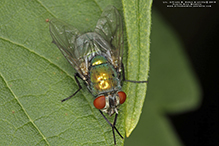 |
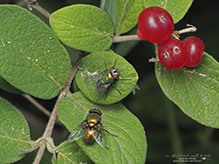 |
|
Bobbi Johnson |
 |
… from the garden |
Bill Reynolds |
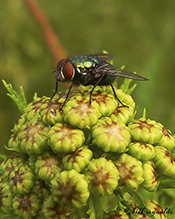 |
MinnesotaSeasons.com Photos |
||
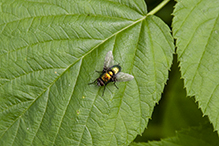 |
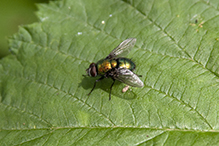 |

Slideshows |
|

Visitor Videos |
||
Share your video of this insect. |
||
This button not working for you? |
||
|
Other Videos |
||
Common green bottle fly (Phaenicia sericata, or Lucilia sericata) |
About
Published on Jul 26, 2014 You can use any of the free content on this channel for your projects. Please follow the license stated below. Common green bottle fly (Phaenicia sericata), filmed in the U.K. on 25 July 2014. Author: The Nature Box |
microscope video: Common green bottle fly / Goldfliege unter dem USB-Mikroskop |
About
Published on Aug 5, 2013 Close-up of a Common green bottle fly. Impressive is the coloration with a metallic look. ### Nahaufnahme von einer Goldfliege. Beeindruckend ist der grün-gold glänzende Körper. |
Birth of Lucilia sericata (Padua - IT) |
About
Published on Feb 6, 2014 Nascita di una Lucilia sericata |

Visitor Sightings |
||
Report a sighting of this insect. |
||
This button not working for you? |
||
Alfredo Colon |
Location: Albany, NY |
 |
Bobbi Johnson |
Location: Silver Bay, MN … from the garden |
 |
| Alfredo Colon 8/2/2022 |
Location: Albany, NY |
 |
J Williams |
Location: Otter Tail County Minnesota |
|
| Alfredo Colon 8/21/2019 |
Location: Woodbury, MN |
 |
MinnesotaSeasons.com Sightings |
||

Created: 9/16/2014 Last Updated: © MinnesotaSeasons.com. All rights reserved. |
